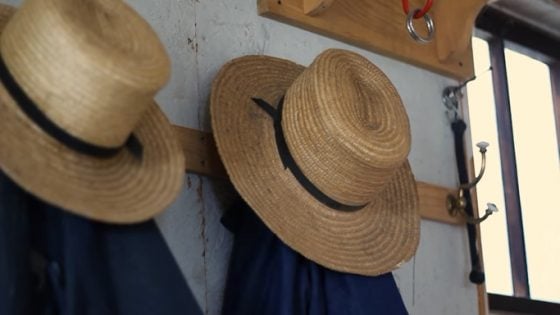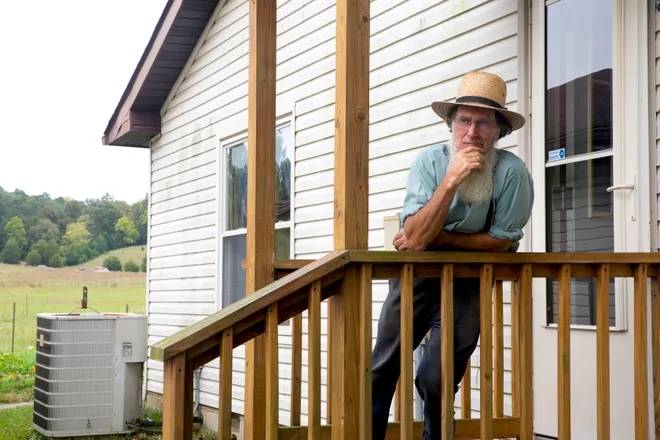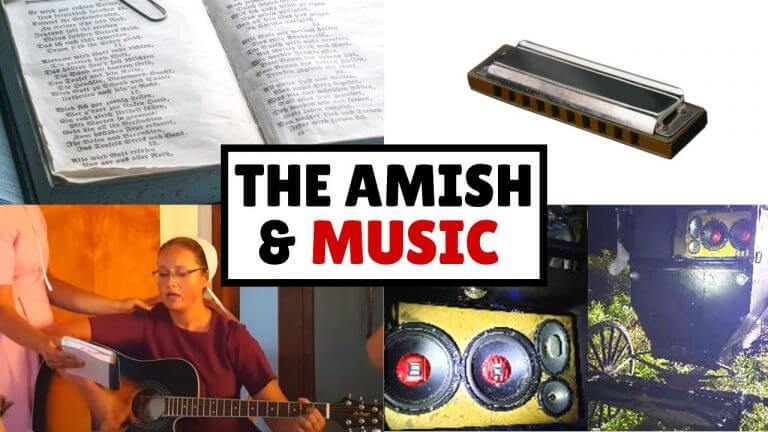Slice Of Amish Life: Business Is Slow
This photo comes from Paoli, Indiana. The photographer took it in 2009. He writes that “I passed these two, three times in two hours and they never had a customer” and that “Even the Amish are having a hard time making a living.” This would have been during the “Great Recession,” so that adds some context to those comments.

Paoli is in southern Indiana. In the Paoli area there are two plain communities – one a Swartzentruber Amish group, another which is just very plain. Which group is this couple from?
This pair have the hallmarks of a Swartzentruber church – clothing, headwear and hair, an open-front buggy without an SMV triangle, and are selling handwoven baskets, a popular item among the Swartzentruber community.
I don’t know in exactly which ways the other Paoli-area group is visually different from Swartzentruber Amish, though they are reportedly very plain with a “low” Ordnung. In some ways they are more strict than even the Swartzentruber Amish (see Steven Nolt and Thomas Meyers’ Plain Diversity for more).

Cindy Cornett Seigle, who has taken photographs in the area, commented at the time that “they are there very frequently.” I wonder if this couple is still appearing at this spot, over a decade later? It’s possible. Or perhaps some of their children have taken on those duties. If so, hopefully they are more busy on this Black Friday than they were back in 2009.
More slices:
Trying On Hats At Yoder’s
Disembarking In Portland
Moving Mountains Of Hay
End Of The Commons
Image credit: Paul/w9ned – flickr








Buggy roof
The Schwartzentruber buggies have rounded tops in Orange County. The other Old Order Amish group there have flat topped buggies. You’re right, they’re even more conservative than the Schwartzentrubers.
Differentiating
The very traditional non-Swartzentruber Amish in the area are most commonly known by the name of the county. They started out of northern Indiana around the same time as the Kenton (OH) community started.
Orange County even goes beyond the Kenton Amish in a number of small ways. As I understand, they refuse to subscribe to the Budget because it has a bar code.
But they are also understanding. Because the men wear vests regularly (not just to church) but they allowed white shirts during the week because some men have problems with the heat during the summer and the white shirt tends to reflect the sunlight and thus the heat.
I believe Mike is correct because they originate from northern Indiana rather than Ohio.
The folks in the picture look more Swartzentruber to me because Orange County men’s hair tends more toward half way over the ear rather than going past the bottom of the ear like Swartzentruber men tend to have. But I could be wrong.
Mike, Isaiah, good info here, thanks. You both shared some interesting detail I wasn’t aware of. I’d make a special trip to visit this corner of Indiana especially considering the two other nearby communities of interest (a Swiss and a New Order community if I’m not mistaken). Would be an interesting day to do the full circuit and visit all of them.
I am very familiar with both communities. The Swartzentruber settlement is also known as the Orleans settlement with four districts (Orleans North, Orleans South, Northeast, and South Mitchell).
I’ve heard the other settlement often referred to as the “Bromer Amish” or “Bromer/Tater Road Amish”. (Bromer is a small town in the northeast part of the settlement and Tater Road (County Road 500 E) is a road in the southwest part of the settlement). In the Plain Diversity book, they are referred to as the “Paoli Settlement” and are in fellowship with the Kenton, Ohio Amish.
I have seen the buggy stand in the picture (at the corner of HWY 150 and HWY 56 in Paoli) many times through the years. I’m not sure who the young woman and man are who are in the picture, which group they are from, or if they are the same ones who have had the buggy stand there through the years. I did observe the buggy stand there in summer/fall of last year (2019), but haven’t been in the area much this year so don’t know if they have been there this year.
Many of the Amish in both settlements sell various products at their farmsteads — produce, baked goods, harnesses, quilts, maple syrup/honey, eggs, greenhouse plants, horse tack, felt hats, baskets, lawn furniture, etc. I am most familiar with those who sell produce. Two families I know quite well in the Swartz. group who have produce stands both told me they did very good business this year — so good that they were glad to see autumn come so they could wind up their business for the year. One of these Swartz. families has a very nice farmstead with a very adequate gravel-covered parking area.They have three buildings they sell from — one with produce, one with baskets and crafts, and one with lawn furniture.
I looked up some of your old comments on this area Al, when I was working on this post (in fact I linked to one from 2014 in the post). I was hoping you’d comment with some additional info to add another layer to this area:)
Would be interesting to get the story of whoever is at the buggy stand now and find out if it is the same couple/family steady throughout the years.
I wonder why the produce stand families had a better year than normal. In this disrupted year I usually first think of the virus as being a likely cause of changes in business but I’m not sure if that would encourage more people to purchase foods etc. from Amish producers. Maybe if access to conventional stores was restricted in the area?
From what I’ve heard, during this COVID 19 period, many people wanted to support local farmers more than in the past. Also, I’m asking around to try to find out more about the status of the buggy stand.
Another interesting development this year, was the heavy demand for home canning supplies. I know a Plain Mennonite woman who has a bulk food store /variety store in central Kentucky who has many Amish as well as non-Amish customer. She sells canning supplies, and said this summer she had many new customers — some driving as many as 60 miles just to buy canning supplies. Some said it was the first time they had ever canned. One Amish family I know who sell home-canned pickles, jams, etc., said they had much difficulty finding canning supplies — especially lids.
That all makes sense. I know people doing the same with their favorite (non-chain) restaurants. Will be curious if you happen to find out more about the stand. The uptick in canning is interesting. I can see that happening since people have been spending a lot more time at home. Hey, look at all this space we have in the backyard, why not plant a garden.